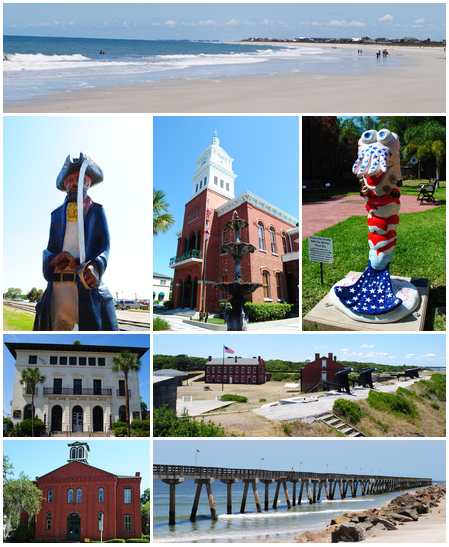
Moving to Fernandina Beach, Florida: A Comprehensive Relocation Guide
Considering moving to Fernandina Beach, Florida? This historic island city offers Victorian charm, pristine beaches, and unique character. As the only incorporated city on Amelia Island with approximately 13,500 residents in 2025, Fernandina Beach combines small-town atmosphere with rich history and Atlantic Ocean lifestyle.
Demographic Profile to Consider If Moving to Fernandina Beach:
Fernandina Beach’s 2025 population is approximately 13,500 residents on the northern end of Amelia Island in Nassau County. The median age is around 52 years, with affluent retirees, professionals, and families attracted to the island’s character. The population is approximately 80% White, 12% Black or African American, and 6% Hispanic. The city features a beautifully preserved historic downtown with over 50 blocks of Victorian buildings, earning National Register designation. Centre Street serves as the downtown hub with shops, restaurants, and galleries. Fernandina Beach balances historic preservation with modern amenities, creating a distinctive island community. The city’s location on Florida’s northeastern coast near the Georgia border provides a different climate and character than South Florida. Find trusted local services for moving, living, and working in Fernandina Beach.Fernandina Beach Relocation Directory
Cost of Living to Consider If Moving to Fernandina Beach:
Fernandina Beach represents upper-tier pricing for Northeast Florida. Median home values range from $450,000 to $600,000 in 2025, with beachfront and historic downtown properties commanding premiums. The median household income is approximately $75,000. Rental properties average $2,000 to $2,800 monthly. Florida’s absence of state income tax benefits residents. Overall cost of living reflects the island’s exclusivity, historic character, and limited development space. Fernandina Beach attracts affluent buyers seeking island lifestyle with Victorian charm and beach access. The city’s character and beaches justify premium pricing for residents seeking distinctive Northeast Florida living.
Economy and Job Market:
Fernandina Beach’s economy centers on tourism, maritime industries, paper manufacturing, and professional services. The Port of Fernandina provides maritime employment and supports logistics operations. Rayonier Advanced Materials operates a paper mill providing significant industrial employment. The historic downtown’s shops, restaurants, and bed-and-breakfasts create tourism-related jobs. Nassau County government and schools employ area residents. Many residents are retirees or work in professional services, real estate, and hospitality. Some commute to Jacksonville, 30 minutes south, for employment in larger corporate and professional sectors. The island’s economy balances tourism, manufacturing, and residential services. Small businesses thrive in the historic downtown district.
Education:
Nassau County School District serves Fernandina Beach students with schools including Fernandina Beach High School, Fernandina Beach Middle School, and several elementary schools on the island. The small district operates schools throughout Nassau County. Florida State College at Jacksonville operates a Nassau County campus providing associate degrees and workforce training. Jacksonville’s universities including the University of North Florida and Jacksonville University are accessible for four-year programs. The school district adequately serves the community’s educational needs with smaller class sizes typical of less-populated counties.
Recreation and Lifestyle:
Fernandina Beach offers 13 miles of pristine Atlantic Ocean beaches with less development than most Florida coasts. The historic downtown Centre Street features Victorian buildings housing boutiques, galleries, restaurants, and the Palace Saloon, Florida’s oldest continuously operating bar. Fort Clinch State Park at the island’s northern tip offers Civil War-era fort tours, fishing pier, beach access, and nature trails. Residents enjoy the monthly First Friday Art Walk, Amelia Island Museum of History, and maritime heritage. The Amelia Island Trail provides paved paths for cycling and walking. Annual events include the Isle of Eight Flags Shrimp Festival. Golf courses, fishing charters, and kayaking in Cumberland Sound provide recreation. The subtropical climate with four mild seasons enables year-round outdoor activities. The city’s Victorian character and island atmosphere create a unique lifestyle.
Healthcare and Services:
Fernandina Beach residents access healthcare through Baptist Medical Center Nassau, a full-service hospital providing emergency care, surgical services, and specialized treatments. Additional facilities include urgent care centers and medical offices throughout Amelia Island. Jacksonville’s major hospitals and specialized care are 30 minutes south when advanced medical services are needed. The area’s healthcare infrastructure serves the local population adequately, with regional facilities accessible for specialized care.
Transportation:
Fernandina Beach is accessed via State Road A1A along the coast and State Road 200 connecting to Interstate 95. Jacksonville International Airport is approximately 35 minutes south. Nassau Transit provides limited public transportation. Most residents rely on personal vehicles. The historic downtown is walkable, and the island’s compact size makes navigation easy. Some residents use golf carts for local travel in certain areas.
Conclusion:
Moving to Fernandina Beach in 2025 offers island living with Victorian charm, pristine beaches, and small-town character. The city’s historic downtown, Atlantic Ocean access, and unique personality make it ideal for those seeking distinctive Northeast Florida lifestyle away from metropolitan hustle.

